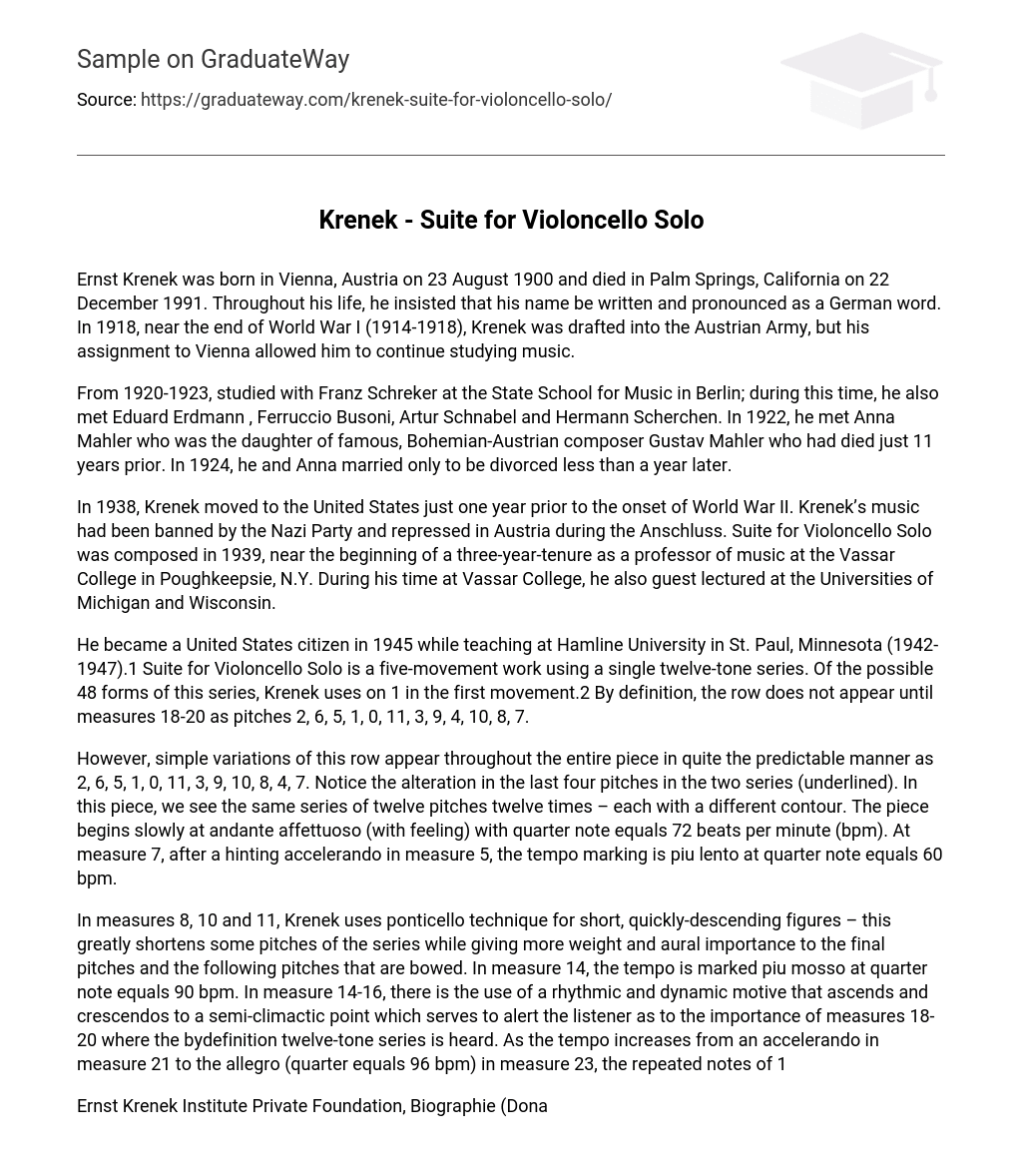Ernst Krenek was born in Vienna, Austria on 23 August 1900 and died in Palm Springs, California on 22 December 1991. Throughout his life, he insisted that his name be written and pronounced as a German word. In 1918, near the end of World War I (1914-1918), Krenek was drafted into the Austrian Army, but his assignment to Vienna allowed him to continue studying music.
From 1920-1923, studied with Franz Schreker at the State School for Music in Berlin; during this time, he also met Eduard Erdmann , Ferruccio Busoni, Artur Schnabel and Hermann Scherchen. In 1922, he met Anna Mahler who was the daughter of famous, Bohemian-Austrian composer Gustav Mahler who had died just 11 years prior. In 1924, he and Anna married only to be divorced less than a year later.
In 1938, Krenek moved to the United States just one year prior to the onset of World War II. Krenek’s music had been banned by the Nazi Party and repressed in Austria during the Anschluss. Suite for Violoncello Solo was composed in 1939, near the beginning of a three-year-tenure as a professor of music at the Vassar College in Poughkeepsie, N.Y. During his time at Vassar College, he also guest lectured at the Universities of Michigan and Wisconsin.
He became a United States citizen in 1945 while teaching at Hamline University in St. Paul, Minnesota (1942-1947).1 Suite for Violoncello Solo is a five-movement work using a single twelve-tone series. Of the possible 48 forms of this series, Krenek uses on 1 in the first movement.2 By definition, the row does not appear until measures 18-20 as pitches 2, 6, 5, 1, 0, 11, 3, 9, 4, 10, 8, 7.
However, simple variations of this row appear throughout the entire piece in quite the predictable manner as 2, 6, 5, 1, 0, 11, 3, 9, 10, 8, 4, 7. Notice the alteration in the last four pitches in the two series (underlined). In this piece, we see the same series of twelve pitches twelve times – each with a different contour. The piece begins slowly at andante affettuoso (with feeling) with quarter note equals 72 beats per minute (bpm). At measure 7, after a hinting accelerando in measure 5, the tempo marking is piu lento at quarter note equals 60 bpm.
In measures 8, 10 and 11, Krenek uses ponticello technique for short, quickly-descending figures – this greatly shortens some pitches of the series while giving more weight and aural importance to the final pitches and the following pitches that are bowed. In measure 14, the tempo is marked piu mosso at quarter note equals 90 bpm. In measure 14-16, there is the use of a rhythmic and dynamic motive that ascends and crescendos to a semi-climactic point which serves to alert the listener as to the importance of measures 18-20 where the bydefinition twelve-tone series is heard. As the tempo increases from an accelerando in measure 21 to the allegro (quarter equals 96 bpm) in measure 23, the repeated notes of 1
Ernst Krenek Institute Private Foundation, Biographie (Donau-Universität-Krems: Austria, 2004) www.krenek.com.
Charles Burkhart, Anthology for Musical Analysis (Belmont: Schirmer/Thomson Learning, 2004) 493. the series only serve to prolong the pitch rather than truly repeat it. In measure 27, there is a prolongation of the pitch D which leads to the tempo marked as Tempo I° (which was andante affettuoso, quarter note equals 72) and leads to the loudest dynamic moment of the piece in measure 30. From measure 30 to the end, the piece slowly begins to calm and a ritardando is observed in measure 32.
Works Cited
- Burkhart, Charles. Anthology for Musical Analysis. Belmont: Schirmer/Thompson, 2004.
- Ernst Krenek Institute Private Foundation. Biogprahie (www.krenek.com). DonauUniversität-Krems: Austria, 2004.





